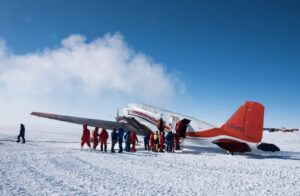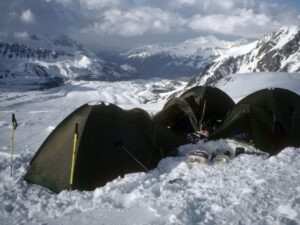The Central Asian country of Tajikistan covers 142,326 square kilometers, more than 90 percent of which is mountainous. Trekking paths weave through the jagged landscape, and a vast web of shepherd and livestock trails interlink them.
With that combination of attributes, it was only a matter of time until someone thought of creating a long-distance hiking experience in the country.
That person is Jan Bakker. An expedition guide and outdoor tourism consultant by trade, Bakker first experienced Tajikistan’s rugged mountains while traveling there and has never forgotten the nation’s splendors. He even wrote a guidebook enumerating Tajikistan’s myriad trekking opportunities.
“It’s remote,” Bakker said in an interview with ExplorersWeb. “It has a negative connotation because it’s close to Afghanistan, but if you ask them what’s [scary] about it, they can’t quite put their finger on it. It’s worth going, for sure.”
Seeking a project at the height of the COVID-19 pandemic, Bakker hit upon the notion of creating a long-distance trail in Tajikistan. So he assembled a rag-tag group of locals, friends, and other contacts he keeps in the expedition world to help him scout possible routes. Their tools? Old Soviet-area maps, publicly available satellite imagery, and on-the-ground exploration.
The Pamir Trail was born.
A work in progress
So far, the coalition has identified over half the route — roughly 850km. It’s hard to say how long the final trail will be.
Knowing that, in America, a problem with creating long-distance trails often springs from securing rights across privately-held land, I asked Bakker if he’d run into the issue.
“Actually, [the real problem] is the complexity of the terrain,” he said.
It seems a few spots in Tajikistan are so rugged that nobody has made trails there yet. That’s saying something for a country that’s been inhabited more or less constantly since the Bronze Age. Puzzling out how to get through certain passes, or around certain landslide-prone areas, is the primary problem Bakker and his team faces.
River crossings are another.
“In 2021 we tried on one of our [exploratory] trips to cross a river, and we were denied. The terrain is brutal and constantly changing. That’s the single biggest challenge.”

River crossings are a key challenge on the fledgling route. This is mellow by comparison to some of the rivers Bakker has scouted. Photo: Jan Bakker
Asking forgiveness rather than permission
Any bridges the team builds would need to be high enough to avoid the bulk of the spring melt as it thunders down out of the mountains. And even then, a lot of the bridges will still wash away. That would require a degree of trail infrastructure that doesn’t currently exist — a trail foundation to monitor the bridges, a team of people contracted to repair them yearly, and so on.
But Bakker is an optimist and is confident such things will happen.
Hopefully, he noted, without the government’s involvement.
“Politics in these kinds of places can be quite a slippery slope,” Bakker said, explaining that local politicians might want the trail routed through areas that would benefit them personally but not the trail itself. In classic “ask for forgiveness rather than permission” fashion, Bakker hopes to establish the route first, then ask for government grants and other forms of assistance with larger infrastructure issues.

Photo: Jan Bakker
He also sees the Pamir trail as a boon to the locals along the trail’s proposed route. Towns on the trail are spaced roughly every four to five trekking days — just right for travelers seeking showers, beds, and hot food before hopping back on the trail. Ask residents of little towns along established long-distance routes worldwide, and they’ll tell you: Such opportunities can be lucrative.
Can I hike it now?
“We’ve had a lot of interest from experienced thru-hikers and more hardcore backcountry trekkers,” Bakker told me toward the end of our conversation. “Go visit. You don’t have to do the whole trail to get a sense of what the country is about.”

Photo: Jan Bakker
The Pamir Trail website has maps, route descriptions, and other info about the completed sections. Just note that the Tajikistan tourist visa is 60 days, and the travel required to piece together the trail as it currently exists would require more time than that. Once the trail is complete (perhaps in 2024, Bakker said), it should be doable within the time constraint.
In the meantime, highly experienced trekkers with knowledge of Central Asia are welcome to help the project by exploring possible routes. Learn more at pamirtrail.org.






